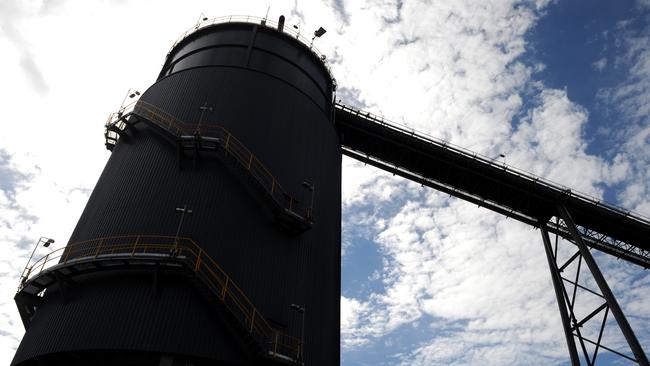Coal surges after NSW floods cut supplies
Thermal coal prices have jumped to their highest level since 2018 after devastating floods in NSW halted rail supplies to Newcastle and saw vessels unable to dock.

Thermal coal prices have jumped to their highest level since 2018 after devastating floods in NSW halted rail supplies to Newcastle and saw vessels unable to dock, sparking forecasts of a tight market as port, rail and mine disruptions persist.
Train movements from the Hunter Valley to Newcastle were halted as a precautionary measure due to severe weather. Newcastle Coal Infrastructure Group (NCIG) – one of three coal terminals at the Port of Newcastle, the world’s largest coal port – was forced to suspend the loading of the fuel onto ships due to equipment issues.
Wild weather forced a backlog of ships outside the Port of Newcastle, with 40 vessels lined up.
Prices for top quality thermal coal have jumped to $US105 a tonne - the highest since October 2018 and more than double a pandemic-low of $US48 in September - and seen increasing further given reduced output from Newcastle for Asian buyers over the next few weeks. At the same time coal futures for May delivery from Newcastle have surged past $US95 a tonne.
About 2m tonnes of coal is expected to be lost from the NCIG shiploader issue, according to consultancy WoodMackenzie, tightening the market in the short-term with more output from Port Waratah not likely to kick in until the second half of 2021.
The price hike may force the government’s commodity forecaster to revisit a downbeat price assessment issued in December, although the loss of output from Australia will pare some of the positive effects.
It predicted Australia’s exports of thermal coal will only edge back slightly to $16bn in 2021-22 from $15bn in 2020-21 against a tough global backdrop with world trade of the commodity declining this year for only the second time this century.
Whitehaven Coal cited flooding, road and rail blockages and shipping problems as it reduced its production and sales forecasts by more than one million tonnes.
Meanwhile mining giant Glencore said it had reduced capacity at some of its NSW mines, as flooding disrupted train movements to Newcastle.
LIVE BLOG: east coast floods crisis
Whitehaven said it was now projecting managed coal sales from its operations to be between 18.5 million tonnes to 19m tonnes in the financial year to end-June, down from the initial guidance of 19m to 20m tonnes for the period.
The $1.8bn coal miner said managed run of mine coal production was now forecast to be 21.4m tonnes to 22m tonnes, down from an initial forecast of 21m to 22.5m tonnes.
“We have updated fiscal 2021 guidance to take into account the above matters, as well as strong recent production performance at Maules Creek and a slower than expected ramp-up of production at Narrabri following the mining through geological faults in Q2 and Q3 fiscal 2021,” Whitehaven Coal said in an ASX statement on Tuesday.
“This updated guidance sees a narrowing of ROM coal production ranges and a reduction in managed coal sales. The situation in relation to flooding and port / infrastructure impacts is still developing and is the focus of continued observation and evaluation.”
The company said further updates will be provided in the March quarterly production report on April 15.
In its ASX statement updating shareholders on the shipping and floods situation in NSW, Whitehaven Coal said Newcastle Coal Infrastructure Group (NCIG) had advised it has suspended shiploading at the Port of Newcastle after a structural assessment of its shiploader SL1 identified faults requiring an expected period of two weeks to be repaired.
NCIG will not have any shiploading capability until the repairs to SL1 are complete, noting that storm-related damage to its other shiploader (SL2) in November 2020 is expected to return to operation in the fourth quarter of calendar 2021.
Since November 2020 Whitehaven has been redirecting ships across to Port Waratah Coal Services where possible.
“Current weather-related port restrictions are also hampering vessel movements at the Port of Newcastle. There is a backlog of vessels at Newcastle, with approximately 40 ships queued.”
The company said a much wetter than average season has been experienced at site and the NSW State Emergency Service released a warning on Monday that flooding is predicted in the Namoi River, in the Gunnedah Basin, in the coming days.
Whitehaven does not expect its coal mines to be flooded but the conditions will disrupt roads and the workforce.
“While Whitehaven does not expect flooding at any of its operations, there is an elevated possibility of temporary inundation of local roads which could disrupt workforce movements and product haulage,” the company said.
“Significant flooding has been seen elsewhere, with the Australian Rail Track Corporation advising that the Hunter Valley rail network is experiencing interruptions due to localised flooding which is expected to subside later this week.”
Glencore said it had reduced capacity at some of its mines across NSW due to the weather conditions, as train movements to the Port of Newcastle were delayed due to minor flooding.
“We continue to monitor the current weather events across NSW and have robust infrastructure installed at each of our sites to minimise impacts,” a company spokesman told The Australian.
“We have taken appropriate precautionary measures, including the decision to operate at reduced capacity at some sites.
“Train movements to the Port of Newcastle have been delayed due to flooding on some parts of the track.
“It is business as usual at our Queensland coal operations”


